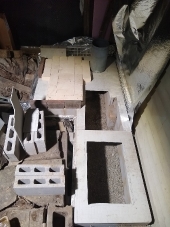
 5
5




 5
5





 9
9




For all your Montana Masonry Heater parts (also known as) Rocket Mass heater parts.
Visit me at
dragontechrmh.com Once you go brick you will never go back!
 6
6




thomas rubino wrote:Hi Heather;
Welcome to Permies, and Welcome to the wonderful world of Rocket Science!
For how to books on Batchbox construction see my website https://dragontechrmh.com/
I offer them in hard copy or digital PDF format.
Let me start by saying I believe an 8" J-Tube will make you much happier than a 6" will.
An 8" uses larger wood and once warmed up will only need fuel every 45 -60 minutes.
Barrels) You only need one, preferably with a removable lid.
Or you can build with no barrel at all if you have plentiful clay bricks to create a brick bell instead.
Your horizontal transition area is easy to create with clay bricks. (Much easier than custom cutting a barrel)
The back 1/3rd of your barrel sits over an empty clay brick box.
Hot air leaving your riser sinks around the outside of the barrel it settles down into the brick box.
Your pipes or your hollow bell start from the brick "mini" bell.
You will only want firebricks on the floor, in the feed tube, burn tunnel, and the first 16" of the riser.
A five minute riser is the fastest easiest way to go, it sits on top of the firebrick riser and is sealed with a fireclay mortar (cob).
Your beach clay will work fine as a cob mass, however, a brick bell is a more modern choice than a piped mass.
Fire clay and a screened graded sand work best for mortaring bricks.
A 2x4 frame filled with 3.5" of a perlite clay mix, is enough to insulate under an RMH
A common method to build on top of wood floors involves using clay bricks set flat on the floor.
A cement board is set on top with 3.5 inches of perlite clay as a base to build your core on.
As you may have noticed there are quite a few upgrades and changes that are now common in RMH construction that are not in the Wisner's Builders Guide.
You can find information on new innovations in the RMH forum or on my website.

 6
6





 6
6








 5
5




For all your Montana Masonry Heater parts (also known as) Rocket Mass heater parts.
Visit me at
dragontechrmh.com Once you go brick you will never go back!
 3
3





 2
2




Fox James wrote:
I have built a sort of highbred J tube with a glass front and a firebox lid that could also be a compromise..
Proudly presenting RocketMassHeaters.com
A good starting point to all RMH research
How Permies.com works
 5
5





|
Yeah, but how did the squirrel get in there? Was it because of the tiny ad?
Learn Permaculture through a little hard work
https://wheaton-labs.com/bootcamp
|






